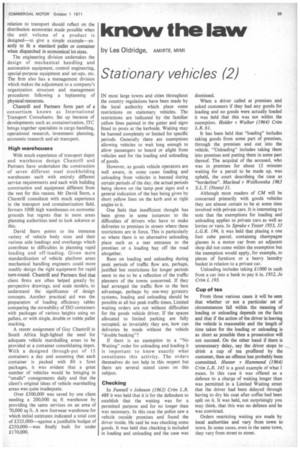know the law
Page 65

If you've noticed an error in this article please click here to report it so we can fix it.
by Les Oldridge, AMIRTE, MIMI
Stationary vehicles (2)
IN most large towns and cities throughout the country regulations have been made by the local authority which place some restrictions on stationary vehicles. The restrictions are indicated by the familiar yellow lines painted in the gutter and signs fitted to posts at the kerbside. Waiting may be banned completely or limited for specific periods. Generally there are exemptions allowing vehicles to wait long enough to allow passengers to board or alight from vehicles and for the loading and unloading of goods.
However, as goods vehicle operators are well aware, in some cases loading and unloading from vehicles is banned during certain periods of the day, the actual periods being shown on the lamp post signs and a general indication of the ban being given by short yellow lines on the kerb and at right angles to it.
One feels that insufficient thought has been given in some instances to the difficulties of drivers who have to make deliveries to premises in streets where these restrictions are in force. This is particularly so where there is no alternative unloading place such as a rear entrance to the premises or a loading bay off the road altogether.
Bans on loading and unloading during peak periods of traffic flow are, perhaps, justified but restrictions for longer periods seem to me to be a reflection of the traffic planners of the towns concerned. If they had arranged the traffic flow to the best advantage, perhaps by one-way gyratory systems, loading and unloading should be possible at all but peak traffic times. Limited waiting orders are not without difficulties for the goods vehicle driver. If the spaces allocated to limited parking are fully occupied, as invariably they are, how can deliveries be made without the vehicle "double banking"?
If there is an exemption to a "No Waiting" order for unloading and loading it is important to know exactly what constitutes this activity. The orders themselves do not help in this respect but there are several stated cases on this subject.
Checking
In Funnell v Johnson (1962) Crim L.& 488 it was held that it is for the defendant to establish that the waiting was for a permitted purpose and for no longer than was necessary. In this case the police saw a vehicle outside premises and found the driver inside. He said he was checking some goods. It was held that checking is included in loading and unloading and the case was
dismissed.
When a driver called at premises and asked customers if they had any goods for loading and no goods were actually loaded it was held that this was not within the exemption. Holder v Walker (1964) Crim L.R. 61.
It has been held that "loading" includes taking goods from some part of premises, through the premises and out into the vehicle. "Unloading" includes taking them into premises and putting them in some part thereof. The acquital of the -accused, who was in premises for about 12 minutes waiting for a parcel to be made up, was upheld, the court describing the case as "borderline". Macleod v Woilkowska 1963 S.LT. (Notes) 51.
Although most readers of CM will be concerned primarily with goods vehicles they are almost certain to be at some time involved with private cars. It is interesting to note that the exemptions for loading and unloading applies to private cars as well as lorries or vans. In Sprake v Tesler 1955, 53 L.G.R. 194. it was held that placing a one foot cube parcel, containing champagne glasses in a motor car from an adjacent shop did not come within the exemption but the exemption would apply, for example, to pieces of furniture or a heavy laundry basket in relation to a private car.
Unloading includes taking £.1000 in cash from a car into a bank to pay it in. 1952, Jo Crim L 193.
Cup of tea
From these various cases it will be seen that whether or not a particular set of circumstances fall within the meaning of loading or unloading depends on the facts and that if the action of the driver in leaving the vehicle is reasonable and the length of time taken for the loading or unloading is as short as possible then a prosecution will not succeed. On the other hand if there is unnecessary delay, say the driver stops to drink a cup of tea proffered by the customer, then an offence has probably been committed. Hunter v Hammond (1964) Crim L.R. 145 is a good example of what I mean. In this case it was offered as a defence to a charge of waiting longer than was permitted in a Limited Waiting street that the driver had been delayed through having to dry his coat after coffee had been spilt on it. It was held, not surprisingly you may think, that this was no defence and he was convicted.
Orders restricting waiting are made by local authorities and vary from town to town. In some cases, even in the same town, they vary from street to street.


















































































































